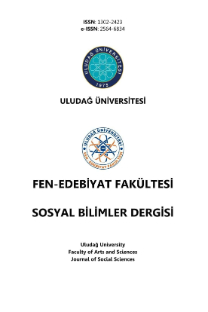A RECONCILIATION of CONFLICTS: JOHN LYLY'S ENDYMION, THE MAN IN THE MOON
John Lyly'nin Endymion, Ay'daki Adam Adlı Oyununda Çatışmaların Uzlaştırılması
___
Primary SourceLyly, J. (1996). Endymion. David Bevington (ed.). Manchester: Manchester UP.
Secondary Sources
Bevington, D. (1996). Introduction, Endymion (pp.1-72). By John Lyly. Manchester: Manchester UP.
Bond, R. W. (1967). Introduction, The Complete Works of John Lyly (pp.1-15). By John Lyly. Vol. III. Oxford: Clarendon P.
Bozio, A. (2016). The Contemplative Cosmos: John Lyly's Endymion and the Shape of Early Modern Space. Studies in Philology, 113(1), 55- 81.
Bradbrook, M. C. (1973). The Growth and Structure of Elizabethan Comedy. Cambridge: Cambridge UP.
Burkert, W. (1979). Structure and History in Greek Mythology and Ritual. Berkeley: U of California P.
Deats, S. (1975). The Disarming of the Knight: Comic Parody in Lyly's Endymion. South Atlantic Bulletin, 40(4), 67-75.
Doran, S. (1996). Monarchy and Matrimony: The Courtships of Elizabeth I. London: Routledge.
Fussell, B. H. (1975). Tragicomedy in Lyly, Shakespeare, and Jonson. Unpublished Dissertation. State University of New Jersey.
Gannon, C. C. (1973). John Lyly's Endymion: From Myth to Allegory. Unpublished Dissertation. University of California.
Knoll, G. (2014). How to Make Love to the Moon: Intimacy and Erotic Distance in John Lyly's Endymion. Shakespeare Quarterly, 65(2), 164- 79.
Knox, J. B. L. (2009). Molière: An Existential Vision of Authenticity in Man Across Time. J. Stewart (ed.), Kierkegaard and the Renaissance and Modern Traditions (pp.125-36). Cornwall: Ashagate.
Kuritz, P. (1988). The Making of Theatre History. New Jersey: Prentice Hall.
Mackenzie, A. M. (1971). The Playgoer's Handbook to English Renaissance Drama. New York: Cooper Square P.
McCarthy, J. H. (2003). Ben Jonson and the Boy Company Tradition. Journal for Early Modern Cultural Studies, 3(1), 1-49.
Schuddebroom, F. (2005). Gods, Goddesses, and Mythology. Vol. 4. New York: Cavendish.
Scragg, L. (2003). Introduction, John Lyly: Selected Prose and Dramatic Work (pp. vii-xxiii). By John Lyly. New York: Routledge.
Seters, J. V. (1983). In Search of History: Historiography in the Ancient World and the Origins of Biblical History. New Haven: Yale UP.
Symonds, J. A. (1967) Shakespeare's Predecessors in the English Drama. New York: Cooper Square P.
Thomas, S. D. (1978). Endimion and Its Sources. Comparative Literature, 30(1), 35-52.
Weltner, P. N. (1971). Translated Mortality: John Lyly's Visionary Theater. Unpublished Dissertation. Indiana University.
Wilson, J. D. (1970). John Lyly. New York: Haskell P.
- ISSN: 1302-2423
- Yayın Aralığı: 2
- Başlangıç: 1999
- Yayıncı: Bursa Uludağ Üniversitesi
CANAN TAN'IN KALEMİNDEN KELEPÇELİ KADINLAR
CRITICAL APPROACHES to EDWARD SAID'S ORIENTALISM
CITY as the RESOURCE of PHILOSOPHY
SES EĞİTİMİ DERSLERİNDE GÖRSEL MATERYAL KULLANIMININ EĞİTİM SÜRECİNE ETKİSİ
A RECONCILIATION of CONFLICTS: JOHN LYLY'S ENDYMION, THE MAN IN THE MOON
John Lylynin ENDYMİON, Kübra VURAL
